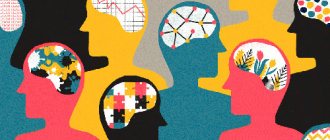The term “Self-concept”, which can be heard today from psychologists of various directions, sociologists and other specialists in the field of the personal sphere of a person, is interpreted as a system of ideas of an individual about himself. These ideas can be perceived by a person to varying degrees and be relatively stable. This concept is the result of a person’s self-knowledge and self-evaluation through individual images within various real and imagined situations, as well as through the opinions of others and a person’s correlation of himself with them.
It doesn't take a genius to come to the conclusion that a person's self-image is very important and has a direct impact on his personality and life. Taking into account the relevance of this topic, we want to talk about the “I-concept”.
The emergence of the “I-concept”
As an independent concept, “I-concept” began to take shape at the turn of the 19th-20th centuries, when ideas about the dual nature of man as a subject of the knower and the known were actively discussed. Then, already in the 50s of the last century, it was developed by phenomenological and humanistic psychological science, the most prominent representatives of which were Abraham Maslow and Carl Rogers. They viewed the single human “I” as the fundamental behavioral and developmental factor. Thus, having appeared in foreign literature on psychology, in the 80s and 90s of the 20th century, the term “Self-concept” became part of domestic psychological science.
Despite this, it is quite difficult to find any precise and unified interpretation of the term in question, and the closest to it in meaning is the term “self-awareness”. The relationship between these two terms is not precisely defined today, but quite often they are considered synonyms. However, in some cases, the “I-concept” is considered separately from self-awareness, acting as a finished product of its processes.
Types of cognitive thinking
Cognitive functions develop in a person from the first days of life. The child receives information about what mom smells like, what food tastes like, and how to call for help. The main stages of development are divided into three stages:
- Visually effective, it is typical for children from birth to 3 years. During this period, children collect information about the world around them using any available means: they taste, remember the smell and appearance of objects. During this period, the child distinguishes between the functions of father and mother, knows in front of whom he can make a scandal and get his way, and on whom his whims do not affect.
- Visual and figurative, it develops until the age of 7. The child learns to think logically and can now perform simple tasks, relying on previously acquired knowledge. At this age, the boundaries of what is permitted are mastered, memory is trained, and imagination develops, which parents often confuse with the desire to deceive.
- Abstract. Over 7 years old, a child already tries to imagine what cannot be touched or seen, and the ability of abstract thinking is mastered.
As children grow up, they attend various clubs and extra classes; parents strive to teach them how to play the piano, dance the waltz, speak foreign languages, and want their children to succeed in the basic program and get high scores.
But after graduating from school, it’s as if all this development ceases to matter. Children receive certificates and diplomas, become adults and are not interested in anything else. The brain stops developing, its potential sharply decreases, and along with it cognitive abilities. With age, specific terms and mathematical formulas are forgotten, and basic knowledge is erased.
Scientists have proven that if you don’t give your brain a workout every day, neural connections disintegrate, which means memory deteriorates and your ability to think decreases. Cognitive disorders appear.
What is “self-concept”?
So, what exactly is the “I-concept” and what psychological meaning should be given to it?
If we turn to psychological dictionaries, then “I-concept” is defined in them as a dynamic system of ideas of an individual about himself. English psychologist Robert Burns in his work “Development of Self-Concept and Education” speaks of “Self-concept” as the totality of all ideas a person has about himself, interconnected with their assessment.
“I-concept” arises in an individual during social interaction as an inevitable and always unique result of mental development, as well as as a relatively stable and, at the same time, subject to internal transformations of mental acquisition.
The initial dependence of the “I-concept” on external influences cannot be disputed, but as it develops, it begins to play an independent role in the life of all people. The surrounding reality and ideas about other people are perceived by people through the filter of “I-concept”, which is formed in the process of socialization and at the same time has specific individual biological and somatic prerequisites.
What are cognitive abilities
Society often divides people into smart and stupid. The principles by which this division occurs are different each time. But the bottom line in most cases is that if you have coped with the task, you are smart. It didn’t work out, I made a mistake - I’m a fool. However, this is an incorrect assessment of human capabilities. The most accurate measure of intelligence is cognitive ability. In simple terms, cognitive skills are the ability to use the fruits of your brain.
If we take students of one class as an example, the teacher will say - this student is smart, he only gets A's, and that student is stupid - he only gets C's. In this case, it is not the child’s ability to think that is assessed, but the ability to remember the text of the paragraph covered and retell it in his own words, or apply the learned formula using an example with numbers. But the child’s perseverance and interest in the material must also be added to the study, which not everyone has.
In addition, memorizing information, reading a lot and reproducing orally memorized text is not an indicator of intelligence, not the level of intelligence. And the ability to apply the acquired knowledge in practice, draw your own conclusions, and weed out unimportant information is already intelligence. This cannot be taught in school; these are individual characteristics of a person.
Cognitive ability is the ability to use information received daily from the environment. Remember it, apply it in everyday life, think logically, draw conclusions from incomplete data. Cognitive means connecting, building cause-and-effect relationships. It is a process that expands knowledge by analyzing the information received and drawing conclusions about it.
How is the “I-concept” formed?
The connections of each person with the outside world are extremely wide and rich. It is in the complex of these connections that a person is forced to function in different roles and qualities, being the subject of all kinds of activities.
Any interaction with the material world allows a person to create an image of his own Self. Through introspection and division of different images of himself into separate formations (both external and internal), a person’s so-called study of his nature and its “discussion” is carried out. According to the Soviet psychologist and philosopher Sergei Leonidovich Rubinstein, the image of the personal Self is constantly integrated into ever new connections, due to which it begins to appear in new qualities, fixed in new concepts. This image, so to speak, constantly shows its new side, each time showing new properties.
In this way, over time, a generalized idea of one’s self is formed, which is, as it were, an “alloy” of individual elements, which is formed in the process of self-perception, self-knowledge, introspection and introspection. This generalized idea of one’s own self, formed from disparate images conditioned by situation, includes the basic ideas and traits of a person about his own nature, which is expressed, in fact, in the “I-concept”. And the “I-concept,” in turn, forms the individual’s sense of self-identity.
Along with all of the above, the “I-concept” formed in the process of a person’s cognition of himself can also be called something that is characterized by constant internal changes - it is not permanent and is not something that is given to a person once and for all. With practice, i.e. real life, both its adequacy and its maturity change. Based on this, the “I-concept” has a huge impact on the individual’s psyche and his worldview, and also serves as a basic factor in the formation of his behavioral type.
Cognitive component of self-concept
All self-descriptive characteristics, such as reliable, conscientious, sociable, kind, etc., are included in the self-image. Ways of self-perception can be different. The hierarchy and significance of the elements of self-description, depending on the context, life experience or the influence of a certain moment, can change.
Self-descriptions are, as a rule, general in nature and do not really correlate with real contexts, because they reflect a general self-perception. On the one hand, as elements of a generalized image of an individual, they reflect stable tendencies of his behavior, and on the other hand, they reflect the selectivity of our perception.
Are you an expert in this subject area? We invite you to become the author of the Directory Working Conditions
When describing himself, a person tries to express the main characteristics of his usual self-perception, for example, a description of property, life goals, etc. With different specific weights, they are all included in the image of the Self, only some seem more significant to the individual, and others - less. R. Burns considered self-description a way to characterize the uniqueness of each personality through a combination of its individual traits.
The structure of the “I-concept”
The above-mentioned Robert Burns, along with many domestic psychologists, defines three elements that make up the “Self-concept”:
- The cognitive component is a person’s self-image, which contains his ideas about his personality
- The evaluative component is self-esteem based on an affective assessment of the self-image
- The behavioral component is behavior consisting of behavioral reactions or specific actions caused by self-image and self-esteem
The presented division of the “I-concept” into individual elements is conditional, because it itself is an integral formation, each of the elements of which, although distinguished by some independence, is in close relationship with each other.
Behavioral component of self-concept
It is a well-known fact that people do not always act in accordance with their beliefs. The direct expression of an attitude in behavior may be restrained due to its social unacceptability, some doubts of the individual, or fear of possible consequences. Any attitude is an emotionally charged belief and it is associated with a certain object, which in the concept is the bearer of the attitude itself. All emotions and evaluations associated with the self-image, as a result of this self-direction, are very strong and stable. It’s enough just not to attach importance to another person’s attitude towards you - there is an arsenal of psychological defense.
It’s another matter if we are talking about attitude towards oneself - verbal manipulations here may be powerless. No one can simply change their attitude towards themselves.
This component has two vectors:
- Expectations regarding oneself, e.g. willingness to act on your own;
- Expectations for others in relation to oneself. This component can be expressed by such statements as “I am always ready...”, “this always happens to me”, etc.
Sometimes the impression may arise that the behavioral component is at the same time the most sensitive to the peculiarities of the life situation and the most rigid, i.e. little changing in its essence, using the same scenarios for solving life problems.
This component of the self-concept is least described by specialists.
The impact of “I-concept” on a person’s life
In the life of each of us, the “I-concept”, by and large, has a triple meaning.
First of all, the “I-concept” ensures the internal consistency of the personality and relative behavioral stability. In the case when the new experience that a person receives does not diverge from his vision of himself, it is easily accepted by the “I-concept”. But if this experience is not consistent with the existing image and contradicts it, psychological defense mechanisms are activated, helping the person either somehow explain the negative experience, or simply reject it. Thanks to this, the “I-concept” remains balanced, even if real experience puts it at risk. According to the idea of Robert Burns, this desire of the individual to protect himself and avoid destructive influences can be called one of the foundations of normal behavior.
The second function of the “I-concept” can be called determining the nature of a person’s understanding of the experience he receives. Self-vision is a specific internal filter that determines the characteristics of an individual’s perception of any event and any situation. When events and situations pass through this filter, they are reinterpreted and given meanings that correspond to the self-concept.
And finally, the third on this list is that the “Self-concept” serves as the basis of a person’s expectations, in other words, his ideas about what should happen. People who are confident in their importance always expect that others will treat them accordingly, and those who doubt their worth tend to believe that no one needs them and no one likes them and, as a result, try to limit them as much as possible. your social contacts.
Hence the conclusion that the development of each person’s personality, as well as his activities and behavior, are always determined by the influence of the “I-concept”.
FINALLY: As you may have noticed, the topic of “Self-concept” is closely related to the process of self-knowledge, which means that if a person understands the characteristics of his personality and is aware of his own “Self-concept”, he can function in the world, interact with others, achieve success and development will become much easier and even more interesting for him. So we suggest that you do not put off working on yourself “on the back burner” and start getting to know yourself now (or at least in the near future) - especially for you, we have created a very interesting and effective course on self-knowledge, which can perhaps reveal to you almost all facets of your “I-concept”. You will find the course here.
We wish you success and productive self-knowledge!
We also recommend reading:
- Storytelling
- Theory of knowledge
- How to get to know yourself better?
- Six Sigma
- Lean concept. Lean
- The influence of social roles on personality development
- Business Ethics: The Triple Criterion Concept
- Philosophical foundations of the linguistic concept of Wilhelm von Humboldt
- Personality criteria
- Linguistic concept of Ferdinand de Saussure
- Vygotsky's concepts: contemporary relevance and actual modernity
Key words:1Psychoregulation
Self-concept as a set of attitudes “towards oneself” Cognitive component of self-concept Evaluative component of self-concept Behavioral component of self-concept
Before you start reading this book, take a look at the diagram (Figure 1). Which of the following characteristics would you attribute to yourself? Mark those that are, in your opinion, the most sustainable. Now distribute the selected characteristics into three columns that express your attitude towards your own qualities. Are there many characteristics that satisfy you? Let's hope the majority. As a result of this simple procedure, you received a sketch of your own portrait (very conditional and fragmentary), which reflected some facets of your self-concept.
| It makes me happy | I don't care | I do not like it |
| I'm happy | ||
| I'm not doing well | ||
| I'm doing well | ||
| I'm slow-witted | ||
| I'm clumsy | ||
| I'm boring | ||
| I am a loser | ||
| I'm conscientious | ||
| I'm a liar | ||
| I'm an introvert | ||
| I'm a dreamer | ||
| I'm an optimist | ||
| I'm a reliable person | ||
| I'm irritable | ||
| I am a good friend | ||
| I'm moody | ||
| I'm sociable | ||
| I'm religious | ||
| I'm smart |
Rice. 1. Self-perception scale
This procedure, of course, has neither reliability nor validity, but it makes you think about what the self-concept is, and gives this concept, which at first glance seems abstract, quite specific outlines. Thus, you have already formed the first, intuitive idea of the Self-concept.
Now let's think about what you were actually doing when working with this circuit. Firstly, you described yourself using a certain set of characteristics, and secondly, you tried to express quite simply your emotional attitude towards your own qualities. Therefore, there were two things in your actions that this book will consider as fundamental aspects of the self-concept. Self-concept is the totality of all representatives of an individual about himself, associated with their assessment. The descriptive component of the self-concept is often called the image of the self or the picture of the self. The component associated with the attitude towards oneself or towards one’s individual qualities is called self-esteem or self-acceptance. The self-concept, in essence, determines not just what an individual is, but also what he thinks about himself, how he looks at his active beginning and possibilities for development in the future.
Self-concept as a set of attitudes “towards oneself”
The identification of descriptive and evaluative components allows us to consider the self-concept as a set of attitudes aimed at oneself. Most definitions of attitude emphasize three main elements:
- A belief that can be either justified or unjustified (the cognitive component of the attitude).
- Emotional attitude to this belief (emotional-evaluative component).
- An appropriate reaction, which, in particular, can be expressed in behavior (behavioral component).
In relation to the self-concept, these three elements of attitude can be specified as follows:
- Self-image is an individual’s idea of himself.
- Self-esteem is an affective assessment of this idea, which can have varying intensity, since specific features of the self-image can evoke more or less strong emotions associated with their acceptance or condemnation.
- Potential behavioral response, that is, specific actions that can be caused by self-image and self-esteem.
The subject of an individual’s self-perception and self-esteem can, in particular, be his body, his abilities, his social relationships and many other personal manifestations, the contribution of which to the self-concept we will consider later. Let us now focus on the three main components of the self-concept.
Cognitive component of self-concept
An individual's ideas about himself, as a rule, seem convincing to him, regardless of whether they are based on objective knowledge or subjective opinion, whether they are true or false. Specific methods of self-perception leading to the formation of an image of self can be very diverse.
When describing a person, we usually resort to adjectives: “reliable”, “sociable”, “strong”, “conscientious”, etc. Weight is an abstract characteristic that is in no way related to a specific event or situation. As elements of a generalized image of an individual, they reflect, on the one hand, stable trends in his behavior, and on the other, the selectivity of our perception. The same thing happens when we describe ourselves: we try to express in words the main characteristics of our habitual self-perception. They can be listed endlessly, because they include any attributive, role, status, psychological characteristics of an individual, a description of his property, life goals, etc. All of them are included in the image of the Self with different specific weight - some seem more significant to the individual, others - less. Moreover, the significance of the elements of self-description and, accordingly, their hierarchy can change depending on the context, the life experience of the individual, or simply under the influence of the moment. This kind of self-description is a way to characterize the uniqueness of each personality through combinations of its individual traits.
Evaluative component of self-concept
The qualities that we attribute to our own personality are not always objective, and other people are probably not always ready to agree with them. Perhaps only age, gender, height, profession and some other data, which are sufficiently indisputable, will cause disagreement. Basically, in attempts to characterize oneself, as a rule, there is a strong personal, evaluative element. In other words, the self-concept is not only a statement, a description of one’s personality traits, but also the entire set of their evaluative characteristics and associated experiences. Even such seemingly objective indicators as height or age can have different meanings for different people, due to the general structure of their self-concept. For example, reaching the age of forty is considered by some to be a time of blossoming, while others consider it the beginning of aging. Some men perceive a height of 170 cm as acceptable, even optimal, while others consider it insufficient. Most of these assessments are due to the corresponding stereotypes that exist in the tone or other social environment. For example, excessive fatness is widely considered undesirable, and people who perceive themselves as too fat (even though they may not be so in the eyes of others) often come to feel inferior. For a person has a tendency to extrapolate even the external defectiveness of his own self to his personality as a whole.
If a person has an unattractive appearance, physical disabilities, or is socially inadequate (even if it only seems so to him), then he feels the negative reactions of others (often also only apparent) that accompany him in any interaction with the social environment. In this case, serious difficulties may arise in the development of a positive self-concept. Even characteristics of one’s own personality that are emotionally neutral at first glance usually contain a hidden assessment. For example, such an insignificant element of the self-concept as place of residence can in some cases acquire an evaluative meaning, associated, for example, with the “prestige” of a given area in the eyes of a certain social group. Having thought about any of the characteristics of your self-description, you will most likely be able to detect in each of them at least a slight evaluative shade, which sometimes exists only on the periphery of consciousness. In fact, whether you are a man or a woman, whether you have success or failure, whether you are an athlete or a fan, whether you are tall or short - all these characteristics, like many others, contain a hidden evaluative meaning, the source of which is your subjective interpretation of reactions. other people to these qualities, as well as the fact that you perceive them both against the backdrop of objectively existing standards, and through the prism of general cultural, group or individual value ideas that you have acquired in the course of life. The affective component of an attitude exists due to the fact that its cognitive component is not perceived by a person indifferently, but awakens in him evaluations and emotions, the intensity of which depends on the context and on the cognitive content itself.
Take any of your own characteristics. Does having these qualities influence your behavior in light of the social, group, or individual values that are important to you? Without knowing you, I will nevertheless answer without hesitation: “Without a doubt.”
A person internalizes the evaluative meaning of various characteristics present in his self-concept. At the same time, the assimilation of new assessments can also change the meaning of those previously acquired. For example, a student who successfully passes exams considers himself a capable student. He is proud and pleased with himself, because this is recognized by others: his successes evoke positive reactions from teachers, meet with support in the family and generally have a favorable social resonance. However, this positive self-esteem may be shaken as a result of a failure in exams or if, among peers, the value of academic performance is pushed into the background by some other value reference point, say, sports achievements. In addition, as a capable student grows up, he may discover that academic success in itself does not bring happiness and is not a guarantee of success in other life situations. In this case, overall self-esteem may decrease, but remain generally positive. Thus, self-esteem is not constant, it changes depending on circumstances. The source of the evaluative meanings of an individual’s various ideas about himself is his sociocultural environment, in which they are normatively fixed in linguistic meanings. For example, the words “boring”, “fat”, “lazy” contain an immanent negative assessment, while “smart”, “brave”, “reliable” - a positive one. The source of an individual’s evaluative ideas can also be social reactions to some of his manifestations and introspection.
In my opinion, the terms “image of the Self” or “picture of the Self,” which are often used in the literature as synonyms for the Self-concept, do not adequately convey the dynamic, evaluative, emotional nature of an individual’s ideas about himself. I prefer to use them to refer only to the first, static, cognitive component of the self-concept; in order to emphasize the presence of the second, evaluative component, most authors resort to the term “self-esteem.” Thus, Coopersmith (1967) calls self-esteem the individual’s attitude towards himself, which develops gradually and acquires a habitual character; it manifests itself as approval or disapproval, the degree of which determines the individual’s conviction in his self-worth and significance. In short, self-esteem is a personal judgment about one’s own worth, which is expressed in the attitudes inherent in the individual. Rosenberg (1965) defines self-esteem in approximately the same way; for him this is a positive or negative attitude aimed at a specific object called the Self. Thus, self-esteem reflects the degree to which an individual develops a sense of self-esteem, a sense of self-worth and a positive attitude towards everything that is included in the sphere of his Self. Therefore, low self-esteem implies self-rejection, self-denial, negative attitude towards one’s personality.
Self-esteem manifests itself in the individual's conscious judgments in which he tries to formulate his importance. However, as has been shown, it is latently or explicitly present in any self-description. Any attempt to characterize oneself contains an evaluative element, determined by generally accepted norms, criteria and goals, ideas about levels of achievement, moral principles, rules of conduct, etc.
There are three points that are essential to understanding self-esteem. Firstly, an important role in its formation is played by the comparison of the image of the real self with the image of the ideal self, that is, with the idea of what a person would like to be. This comparison often appears in various psychotherapeutic techniques, and a high degree of agreement between the real self and the ideal self is considered an important indicator of mental health. In the classical concept of James (1890), the idea of actualizing the ideal Self is based on the concept of self-esteem, which is defined as a mathematical ratio - the real achievements of an individual to his claims. So, whoever achieves in reality the characteristics that define for him the ideal image of the Self must have high self-esteem. If a person perceives a gap between these characteristics and the reality of his achievements, his self-esteem is likely to be low.
The second factor important for the formation of self-esteem is associated with the internalization of social reactions to a given individual. In other words, a person tends to evaluate himself the way he thinks others evaluate him. This approach to understanding self-esteem was formulated and developed in the works of Cooley (1912) and Mead (1934).
Finally, another view on the nature and formation of self-esteem is that an individual evaluates the success of his actions and manifestations through the prism of his identity. An individual experiences satisfaction not from the fact that he simply does something well, but from the fact that he has chosen a certain task and is doing it well. The overall picture is that people make great efforts to “fit” into the structure of society with the greatest success.
It should be especially emphasized that self-esteem, regardless of whether it is based on the individual’s own judgments about himself or interpretations of the judgments of other people, individual ideals or culture but given standards, is always subjective.
Data from specific studies convince us that motivational and attitudinal structures are truly omnipresent for the human self. Therefore, we can confidently capture in the self-concept not only its cognitive component, but also its emotional, evaluative and potential behavioral component. A wide variety of sources give us grounds for this conclusion. So, in our book we will consider the self-concept as a dynamic set of attitudes characteristic of each personality, aimed at the personality itself.
As follows from this definition, a positive self-concept can be equated to a positive attitude towards oneself, self-respect, self-acceptance, a sense of self-worth; In this case, synonyms for a negative self-concept become a negative attitude towards oneself, self-rejection, and a feeling of inferiority. These terms are used interchangeably in much of the work on self-concept. In this book, we will also use them as synonyms, because they all denote an individual’s idea of himself, containing an element of shade - in the range from unconditionally positive to unconditionally negative meanings.
In the literature devoted to self-concept, one can find two detailed definitions of it. Both of these are consistent with the point made above. The first definition is due to Rogers (1951). He argues that the self-concept consists of ideas about an individual's own characteristics and abilities, ideas about the possibilities of his interaction with other people and with the world around him, value concepts associated with objects and actions, and ideas about goals or ideas that can have a positive impact. or negative direction. Thus, it is a complex structured picture that exists in the mind of the individual as an independent figure or background and includes both the Self itself and the relationships into which it can enter, as well as positive and negative values associated with the perceived qualities and relationships of the Self - in past, present and future.
In the second definition, due to Staines (1954), the self-concept is formulated as a system of ideas, images and assessments existing in the mind of an individual that relate to the individual himself. It includes evaluative ideas that arise as a result of the individual's reactions to himself, as well as ideas about how he looks in the eyes of other people; on the basis of the latter, ideas are formed about what he would like to be and how he should behave.
In conclusion, we add that, despite the use of the term “I-concept” in the singular, we mean the plurality of attitudes it covers.
Behavioral component of self-concept
The fact that people do not always behave in accordance with their beliefs is well known. Often, the direct, immediate expression of an attitude in behavior is modified or completely restrained due to its social unacceptability, the individual’s moral doubts, or his fear of possible consequences. For example, a teenager who considers himself a firm and stern person cannot demonstrate similar character traits towards his school teacher. Or a graduate of a pedagogical college, a humanist and an opponent of authoritarian methods in education, is forced to restructure, retreat from this position, faced with the reality of a particular school, where certain norms of relationships between teachers and students already exist.
Any attitude is an emotionally charged belief associated with a specific object. The peculiarity of the self-concept as a complex of attitudes lies only in the fact that the object in this case is the bearer of the attitude itself. Thanks to this self-direction, all emotions and evaluations associated with the self-image are very strong and stable. It is quite simple not to attach importance to another person’s attitude towards you; For this purpose, there is a rich arsenal of psychological defenses. For example, if you don’t like the cut of my new suit, I can always convince myself that you have no taste, that you don’t know the latest fashion, or come up with any other excuse that protects me from unpleasant judgments. But if we are talking about attitude towards oneself, then simple verbal manipulations may be powerless here. A person who is tired of everyday activities can take a vacation, change jobs, move to another city, or change the situation in some other way. But can he escape from himself?
Concept and structure
Self-concept is a system of psychological attitudes of an individual that relate to himself. It is formed and develops as one grows up and develops as an individual in society.
The processes of self-knowledge are influenced by many factors. Some of them are changed by a person himself, others do not depend on him.
Considering the structure of the self-concept, psychologists distinguish three components - cognitive, evaluative, and behavioral. Each of them covers different areas of self-esteem.
Cognitive
The cognitive component of the self-concept is a set of beliefs that can be true or deceptive.
Looking at beliefs in more detail, we can say that they have different significance. For example, a person considers himself brave, pays special attention to this, but at the same time does not think about his strength at all. The hierarchy of beliefs itself is not constant.
It can change with the stages of growing up, the influence of society, and social status.
Estimated
Each person constantly evaluates his characteristics. Estimates are formed under the influence of several factors:
- determining the effectiveness of one’s own activities;
- comparison of current social status;
- comparison of the idea of the ideal self.
Behavioral
The behavioral component of the self-concept is an objective opinion about oneself. A person cannot deny his behavior, words, actions, mistakes.










